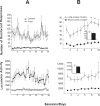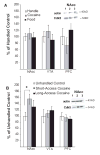Increased accumbens Cdk5 expression in rats after short-access to self-administered cocaine, but not after long-access sessions
- PMID: 17339080
- PMCID: PMC1876973
- DOI: 10.1016/j.neulet.2007.02.043
Increased accumbens Cdk5 expression in rats after short-access to self-administered cocaine, but not after long-access sessions
Abstract
Upregulation of cyclin-dependent kinase 5 (Cdk5) after chronic cocaine administration has led to speculation that Cdk5 plays an important role in drug addiction. However, as Cdk5 involvement is implicated in a variety of neural events, including neuronal development, synaptic plasticity and learning, a specific role in drug abuse is yet to be determined. The present study utilized cocaine self-administration and food-reinforced operant procedures to assess possible relationships between cocaine intake, food-reinforced operant responding, behavioral activity, and Cdk5 levels in the nucleus accumbens (NAcc), ventral tegmental area (VTA), and prefrontal cortex (PFC) in rats. In Experiment 1, animals undergoing daily cocaine self-administration (1-h/30 days) or food-reinforced operant sessions (20-min/30 days) showed significant between-group differences in operant responding and behavioral activity, but no significant differences in NAcc, VTA or PFC Cdk5 levels compared to a Handled Control group. In Experiment 2, animals that had self-administered cocaine in 10 daily 1-h sessions (Short-Access Cocaine) showed significantly greater NAcc Cdk5 expression compared to an Unhandled Control group, and no evidence of cocaine-induced behavioral sensitization. Animals given 4-h daily access to cocaine over the same number of sessions (Long-Access Cocaine) showed significantly enhanced cocaine-reinforced responding and locomotor activation by the end of the sessions, but no significant differences in Cdk5 expression compared to Control animals. These findings suggest that overexpression of Cdk5 may be a transient adaptation to cocaine experience that subsides with increased cocaine exposure and does not correspond with measures of cocaine-induced behavioral sensitization.
Figures



Similar articles
-
Acupuncture attenuates cocaine-induced expression of behavioral sensitization in rats: possible involvement of the dopaminergic system in the ventral tegmental area.Neurosci Lett. 2009 Jan 9;449(2):128-32. doi: 10.1016/j.neulet.2008.10.089. Epub 2008 Oct 30. Neurosci Lett. 2009. PMID: 18992788
-
Neuroadaptations of total levels of adenylate cyclase, protein kinase A, tyrosine hydroxylase, cdk5 and neurofilaments in the nucleus accumbens and ventral tegmental area do not correlate with expression of sensitized or tolerant locomotor responses to cocaine.J Neurochem. 2005 Feb;92(3):536-45. doi: 10.1111/j.1471-4159.2004.02891.x. J Neurochem. 2005. PMID: 15659224
-
Amphetamine and cocaine do not increase Narp expression in rat ventral tegmental area, nucleus accumbens or prefrontal cortex, but Narp may contribute to individual differences in responding to a novel environment.Eur J Neurosci. 2002 Jun;15(12):2027-36. doi: 10.1046/j.1460-9568.2002.02036.x. Eur J Neurosci. 2002. PMID: 12099908
-
Brain-derived neurotrophic factor and cocaine addiction.Brain Res. 2010 Feb 16;1314:183-93. doi: 10.1016/j.brainres.2009.08.078. Epub 2009 Sep 2. Brain Res. 2010. PMID: 19732758 Free PMC article. Review.
-
Cortical mechanisms of cocaine sensitization.Crit Rev Neurobiol. 2005;17(2):69-86. doi: 10.1615/critrevneurobiol.v17.i2.20. Crit Rev Neurobiol. 2005. PMID: 16808728 Review.
Cited by
-
Systemic Administration of the Cyclin-Dependent Kinase Inhibitor (S)-CR8 Selectively Reduces Escalated Ethanol Intake in Dependent Rats.Alcohol Clin Exp Res. 2019 Oct;43(10):2079-2089. doi: 10.1111/acer.14177. Epub 2019 Aug 30. Alcohol Clin Exp Res. 2019. PMID: 31403700 Free PMC article.
-
Protein kinases and addiction.Ann N Y Acad Sci. 2008 Oct;1141:22-57. doi: 10.1196/annals.1441.022. Ann N Y Acad Sci. 2008. PMID: 18991950 Free PMC article. Review.
-
Glutathione and redox signaling in substance abuse.Biomed Pharmacother. 2014 Jul;68(6):799-807. doi: 10.1016/j.biopha.2014.06.001. Epub 2014 Jun 24. Biomed Pharmacother. 2014. PMID: 25027386 Free PMC article. Review.
-
The role of neuronal nitric oxide synthase in cocaine place preference and mu opioid receptor expression in the nucleus accumbens.Psychopharmacology (Berl). 2018 Sep;235(9):2675-2685. doi: 10.1007/s00213-018-4961-1. Epub 2018 Jul 10. Psychopharmacology (Berl). 2018. PMID: 29992335
-
Individual differences in prefrontal cortex function and the transition from drug use to drug dependence.Neurosci Biobehav Rev. 2010 Nov;35(2):232-47. doi: 10.1016/j.neubiorev.2010.05.002. Epub 2010 May 20. Neurosci Biobehav Rev. 2010. PMID: 20493211 Free PMC article. Review.
References
-
- Ben-Shahar O, Moscarello JM, Jacob B, Roarty MP, Ettenberg A. Prolonged daily exposure to i.v. cocaine results in tolerance to its stimulant effects. Pharmacol Biochem Behav. 2005;82:411–6. - PubMed
-
- Benavides DR, Bibb JA. Role of Cdk5 in drug abuse and plasticity. Ann N Y Acad Sci. 2004;1025:335–44. - PubMed
-
- Bibb JA, Chen J, Taylor JR, Svenningsson P, Nishi A, Snyder GL, Yan Z, Sagawa ZK, Ouimet CC, Nairn AC, Nestler EJ, Greengard P. Effects of chronic exposure to cocaine are regulated by the neuronal protein Cdk5. Nature. 2001;410:376–80. - PubMed
-
- Fuchs H, Nagel J, Hauber W. Effects of physiological and pharmacological stimuli on dopamine release in the rat globus pallidus. Neurochem Int. 2005;47:474–81. - PubMed
MeSH terms
Substances
Grants and funding
LinkOut - more resources
Full Text Sources
Medical
Miscellaneous

